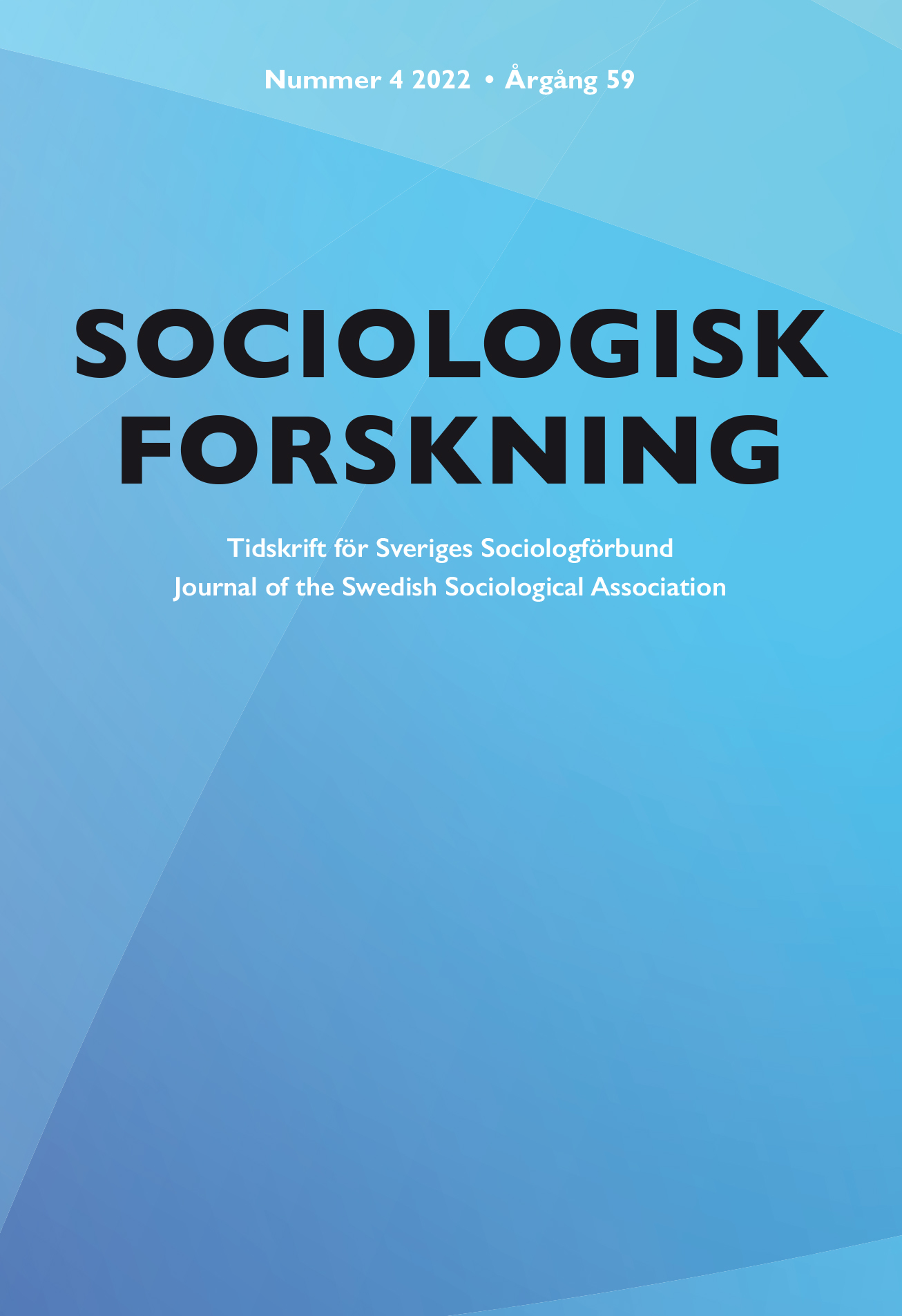Leader interlocks in Swedish civil society organizations
A network analysis
DOI:
https://doi.org/10.37062/sf.59.23997Nyckelord:
Association network, board-director network, civil society organization, network analysis, SwedenAbstract
This paper contributes to the understanding of power structures in civil society by the exploring organizational connections of leaders holding multiple top-level leadership positions in resource-rich civil society organizations (CSOs) in Sweden. Based on unique association network data among national level CSOs collected in 2018, we discuss possible explanations behind the observed clusters of organizational connections via leader interlocks. Our results show that the resource-rich, national CSOs in Sweden are highly connected with each other via leader interlocks. We find that working within similar policy areas, sharing similar ideological backgrounds or historical legacies, and being a member of sectoral umbrella organizations or federations are among the salient characteristics of CSOs connected via leader interlocks. We suggest a multilevel understanding of leader interlocks among CSOs, including those at the individual level, as an avenue for further research. The focus on the individual level explanation would allow an understanding of the field of CSOs through the lens of an elite phenomenon rather than an organization-centered view.
Referenser
Amnå, E. (2006) “Still a trustworthy ally? Civil society and the transformation of Scandinavian democracy”, Journal of Civil Society 2 (1):1–20. https://doi.org/10.1080/17448680600730884
Borgatti, S.P., M.G. Everett & J.C. Johnson (2018) Analyzing social networks. Second edition. Los Angeles: Sage.
Bouwman, C.H.S. (2011) “Corporate governance propagation through overlapping directors”, The Review of Financial Studies 24 (7):2358–2394. https://doi.org/10.1093/rfs/hhr034
Brown, W.A. & C. Guo (2010) “Exploring the key roles for nonprofit boards”, Nonprofit and Voluntary Sector Quarterly 39 (3):536–546. https://doi.org/10.1177/0899764009334588
Buch-Hansen, H. (2014a) “Social network analysis and critical realism”, Journal for the Theory of Social Behavior 44 (3):306–325. https://doi.org/10.1111/jtsb.12044
Buch-Hansen, H. (2014b) “Interlocking directorates and collusion: An empirical analysis”, International Sociology 29 (3):249–267. https://doi.org/10.1177/0268580914527021
Bühlmann, F., T. David & A. Mach (2012) “The Swiss business elite (1980–2000): How the changing composition of the elite explains the decline of the Swiss company network”, Economy and Society 41 (2):199–226. https://doi.org/10.1080/03085147.2011.602542
Cornforth, C. & C. Edwards (1999) “Board roles in the strategic management of non-profit organizations: Theory and practice”, Corporate Governance 7 (4):346–362. https://doi.org/10.1111/1467-8683.00165
Davis, G.F., M. Yoo & W.E. Baker (2003) “The small world of the American corporate elite, 1982–2001”, Strategic Organization 1 (3):301–326. https://doi.org/10.1177/14761270030013002
Diamond, L. (1994) “Rethinking civil society: Toward democratic consolidation”, Journal of Democracy 5 (3):4–17. https://doi.org/10.1353/jod.1994.0041
DiMaggio, P.J. & W.W. Powell (1983) “The iron cage revisited: Institutional isomorphism and collective rationality in organizational fields”, American Sociological Review 48 (2):147–160. https://doi.org/10.2307/2095101
Einarsson, T. (2012) Membership and organizational governance. Stockholm: Stockholm School of Economics.
Faulk, L., J. Willems, J. McGinnis Johnson & A.J. Steward (2016) “Network connections and competitively awarded funding: The impacts of board network structures and status interlocks on nonprofit organizations’ foundation grant acquisition”, Public Management Review 18 (10):1425–1455. https://doi.org/10.1080/14719037.2015.1112421
Granovetter, M. (1985) “Economic action and social structure: The problem of embeddedness”, American Journal of Sociology 91 (3):481–510. https://doi.org/10.1086/228311
Guo, C. & M. Acar (2005) “Understanding collaboration among nonprofit organizations: Combining resource dependency, institutional, and network perspectives”, Nonprofit and Voluntary Sector Quarterly 34 (3):340–361. https://doi.org/10.1177/0899764005275411
Harding, T. (2012) Framtidens civilsamhälle: Underlagsrapport 3 till Framtidskommissionen. Stockholm: Statsrådsberedningen, Regeringskansliet.
Hermansson, J., A. Lund, T. Svensson & P.O. Öberg (1999) Avkorporativisering och lobbyism: Konturerna till en ny politisk modell. SOU 1999:121. Stockholm: Fakta info direkt.
Hvenmark, J. (2008) Reconsidering membership: A study of individual members’ formal affiliation with democratically governed federations. Stockholm: Stockholm School of Economics.
Ihm, J. & M. Shumate (2019) “How does a board of directors influence within- and cross-sector nonprofit collaboration?”, Nonprofit Management & Leadership 29 (4):473–490. https://doi.org/10.5465/ambpp.2016.13238
Jensen, M.C. & W.H. Meckling (1976) “Theory of the firm: Managerial behavior, agency costs, and ownership structure”, Journal of Financial Economics 3 (4):305–360. https://doi.org/10.1016/0304-405X(76)90026-X
Johansson, H., A. Kassman & R. Scaramuzzino (2011) Staten och det civila samhällets organisationer i ett föränderligt välfärdssamhälle: Perspektiv på en överenskommelse. Stockholm: Överenskommelsen.
Johansson, H. & S. Kalm (Eds.) (2015) EU civil society: Patterns of cooperation, competition and conflict. London: Palgrave Macmillan. https://doi.org/10.1057/9781137500724
Jönsson, H. (2006) “Det är orättvist! De svenska pensionärsorganisationernas bilder av äldre 1941–1995”, 25–37 in L. Svedberg & L. Trägårdh (Eds.) Det civila samhället som forskningsfält: Nya avhandlingar i ett nytt sekel. Stockholm: Riksbankens Jubileumsfond & Gidlunds förlag.
Keane, J. (2009) The life and death of democracy. New York: Simon & Schuster.
Knox, H., M. Savage & P. Harvey (2006) “Social networks and the study of relations: Networks as method, metaphor and form”, Economy and Society 35 (1):113–140. https://doi.org/10.1080/03085140500465899
Lee, J. & R. Scaramuzzino (2022) “Professionalization in welfare-oriented civil society organizations: Comparison of board chairs and executive directors concerning motives for engagement and leadership ideals”, Nordic Social Work Research. Published online. https://doi.org/10.1080/2156857X.2022.2158916
Lindvall, J. & J. Sebring (2005) “Policy reform and the decline of corporatism in Sweden”, West European Politics 28 (5):1057–1074. https://doi.org/10.1080/01402380500311814
Lundström, T. & L. Svedberg (2003) “The voluntary sector in a social democratic welfare state: The case of Sweden”, Journal of Social Policy 32 (2):217–238. https://doi.org/10.1017/S0047279402007006
McCarthy, J.D. & M.N. Zald (1977) “Resource mobilization and social movements: A partial theory”, American Journal of Sociology 82 (6):1212–1241. https://doi.org/10.1086/226464
Meeuwisse, A. & R. Scaramuzzino (Forthcoming) “Producing leadership legitimacy in civil society: A study of online presentations of leaders in Sweden”, Journal of Civil Society. Accepted for publication.
Messamore, A. (2021) “The civic elite: A network perspective on elite consolidation among community-based organizations, 1998–2016”, Social Networks 66:146–160. https://doi.org/10.1016/j.socnet.2021.02.006
Meyer, J.W. & B. Rowan (1977) “Institutionalized organizations: Formal structure as myth and ceremony”, American Journal of Sociology 83 (2):340–363. https://doi.org/10.1086/226550
Micheletti, M. (1991) “Swedish corporatism at a crossroads: The impact of new politics and new social movements”, West European Politics 14 (3):144–165. https://doi.org/10.1080/01402389108424863
Middleton, M. (1987) “Nonprofit boards of directors: Beyond the governance function”. 141–153 in W.W. Powell (Ed.) The nonprofit sector: A research handbook. New Haven: Yale University Press.
Miller-Millesen, J. (2003) “Understanding the behavior of nonprofit boards of directors: A theory-based approach”, Nonprofit and Voluntary Sector Quarterly 32 (4):521–547. https://doi.org/10.1177/0899764003257463
Mizruchi, M.S. (1996) “What do interlocks do? An analysis, critique, and assessment of research on interlocking directorates”, Annual Review of Sociology 22 (1):271–298. https://doi.org/10.1146/annurev.soc.22.1.271
Moore, G., S. Sobieraj, J.A. Whitt, O. Mayorova & D. Beaulieu (2002) “Elite interlocks in three U.S. sectors: Nonprofit, corporate, and government”, Social Science Quarterly 83 (3):726–744. https://doi.org/10.1111/1540-6237.00111
Paarlberg, L.E., B. Hannibal & M. Johnson (2020) “Examining the mediating influence of interlocking board networks on grant making in public foundations”, Nonprofit and Voluntary Sector Quarterly 49 (4):734–756. https://doi.org/10.1177/0899764019897845
Pfeffer, J. & G.R. Salancik (1978) The external control of organizations: A resource dependence perspective. New York: Harper & Row.
Pierre, J. & B. Rothstein (2003) Välfärdsstat i otakt: Om politikens oväntade, oavsiktliga och oönskade effekter. Stockholm: Liber.
Rolf, H. (2020) En fackförening för hemmen: Kollektiv mobilisering, hyresgästorganisering och maktkamp på hyresmarknaden i Stockholm och Göteborg 1875–1942. Stockholm: Ersta Sköndal Bräcke högskola.
Sandahl, A. & M. Rodikova (2015) Sensus: Med historien mot framtiden. Stockholm: Sensus.
Scaramuzzino, R. & J. Lee (2020) “Mapping civil society elites: Multi-dimensional measure of resource stratification in civil society (MMRSC)”. Paper presented at the 6th Interim Conference of the Political Sociology Research Network 32 of the European Sociological Association 30 October 2020, Maynooth, Ireland.
Scaramuzzino, R. & M. Wennerhag (2019) “Europeanization of Swedish civil society: Motives, activities, and perceived consequences”, 75–107 in A. Meeuwisse & R. Scaramuzzino (Eds.) Europeanization in Sweden: Opportunities and challenges for civil society organizations. New York: Berghahn Books. https://doi.org/10.1515/9781789200355-007
Stark, D. & B. Vedres (2012) “Political holes in the Economy: The business network of partisan firms in Hungary”, American Sociological Review 77 (5):700–722. https://doi.org/10.1177/0003122412453921
Trägårdh, L. (2007) “The ‘civil society’ debate in Sweden: The welfare state challenged”, 9–36 in L. Trägårdh (Ed.) State and civil society in northern Europe: The Swedish model reconsidered. New York: Berghahn Books. https://doi.org/10.2307/j.ctt1x76dkp.8
Vedres, B. & D. Stark (2010) “Structural folds: Generative disruption in overlapping groups”, American Journal of Sociology 115 (4):1150–1190. https://doi.org/10.1086/649497
Vogel, J., E. Amnå, I. Munck & L. Häll (2003) Föreningslivet i Sverige: Välfärd, socialt kapital, demokratiskola. Stockholm: Statistics Sweden.
Willems, J., S. van Puyvelde, M. Jegers, M. Vantilborgh, T. Bidee & R. Pepermans (2015) “Exploring board interlocking behaviour between nonprofit organizations”, Annals of Public & Cooperative Economics 86 (1):73–88. https://doi.org/10.1111/apce.12067
Yoon, N. (2022) “Nonprofit board governance policy adoption: Toward an integrated board interlock network and institutional perspectives”, Nonprofit and Voluntary Sector Quarterly 51 (5):1074–1094. https://doi.org/10.1177/08997640211057452
Yoon, N. (2023) “The antecedents of nonprofit board interlock: A longitudinal examination on network structure, homophily, and organizational attributes”, Nonprofit and Voluntary Sector Quarterly 52 (1):196–221. https://doi.org/10.1177/08997640211067519
Downloads
Publicerad
Referera så här
Nummer
Sektion
Licens
Copyright (c) 2023 Jayeon Lindellee, Roberto Scaramuzzino

Detta verk är licensierat under en Creative Commons Erkännande-Ickekommersiell-IngaBearbetningar 4.0 Internationell-licens.
Allt material i Sociologisk Forskning publiceras med omedelbar öppen tillgång (open access), under Creative Commons-licensen CC BY-NC-ND 4.0.
Allt innehåll i tidskriften är fritt tillgängligt utan kostnad och får för icke-kommersiella syften fritt läsas, laddas ned, kopieras, delas, skrivas ut och länkas. Innehållet får dock inte ändras. När innehållet används måste författare och källa anges. Upphovsrätten till innehållet tillhör respektive författare. Inga publiceringsavgifter tas ut.





